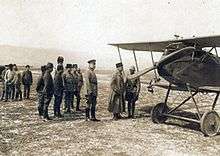Halberstädter Flugzeugwerke

Halberstädter Flugzeugwerke or Halberstadt was a German aircraft manufacturer. It was formed on 9 April 1912 under the name Deutsche Bristol Werke Flugzeug-Gesellschaft mbH in Halberstadt, Province of Saxony.
History

The British-German joint venture initially produced planes according to the system by the British and Colonial Aeroplane Company, Ltd such as Bristol Boxkites and Bristol Prier monoplanes, but soon expanded into their own developments. In September 1913 the company was renamed Halberstädter Flugzeugwerke GmbH. The chief designers were Hans Burkhardt, who later transferred to Gothaer Waggonfabrik, and the technical director and chief engineer was Karl Theiss.
The company built more than 1,700 reconnaissance aircraft (C type) and 85 fighter planes (D type), which served in the Luftstreitkräfte (German Air Force) during World War I. When German aircraft production was prohibited according to the 1919 Treaty of Versailles, the company, renamed Berlin-Halberstädter Industriewerke AG resorted to the production of agricultural machines and the repair of Reichsbahn railroad cars. Insolvency proceedings were opened in 1926; the Halberstadt factory premises where used by Junkers from 1935.
Aircraft
Beside flight school aircraft (A type), Halberstadt produced scout-planes, ground attack aircraft, and fighters:
Halberstadt B types
B type planes were dual-seated unarmed reconnaissance aircraft built in 1914/15. The biplanes were equipped with Oberursel-Gnome rotary engines, later (B.II and B.III) with Mercedes six-cylinder straight engines.
- Halberstadt B.I
- Halberstadt B.II
- Halberstadt B.III
Halberstadt C types

- Halberstadt C.I
- Halberstadt C.III
- Halberstadt C.V
- Halberstadt C.VII
- Halberstadt C.VIII
- Halberstadt C.IX
- Halberstadt CL.II
- Halberstadt CL.IV
- Halberstadt CLS
Halberstadt D types
- Halberstadt D.I
- Halberstadt D.II
- Halberstadt D.III
- Halberstadt D.IV
- Halberstadt D.V
- Halberstadt G.I
References
- Kroschel, Günter; Stützer, Helmut: The German military aircraft 1910-18, Wilhelmshaven 1977